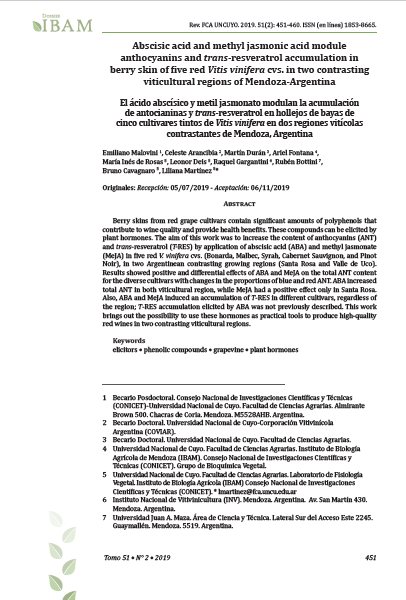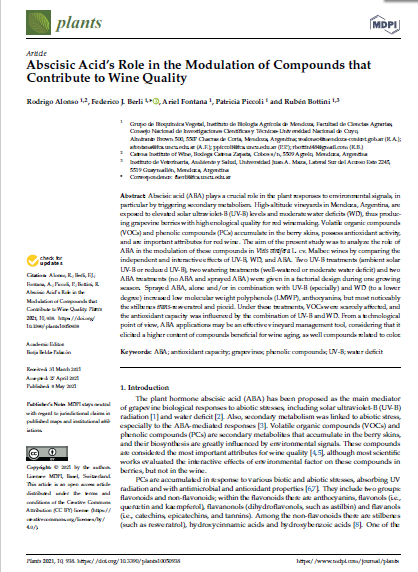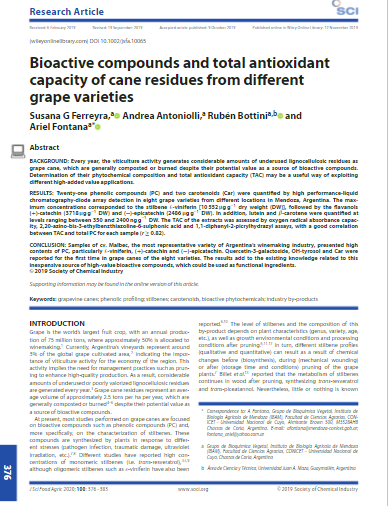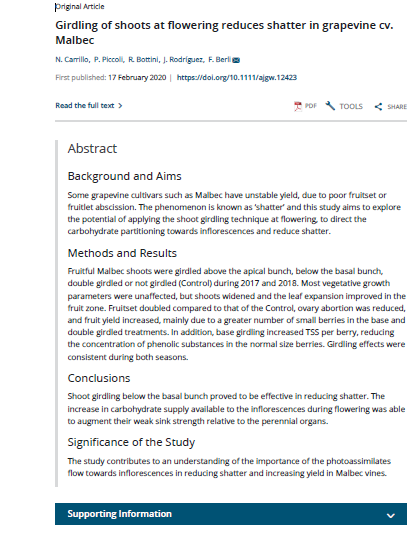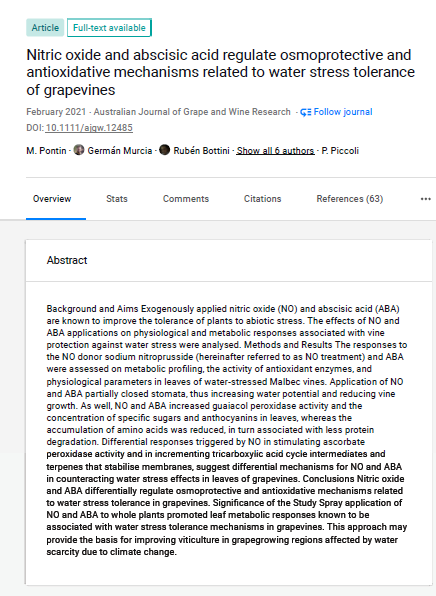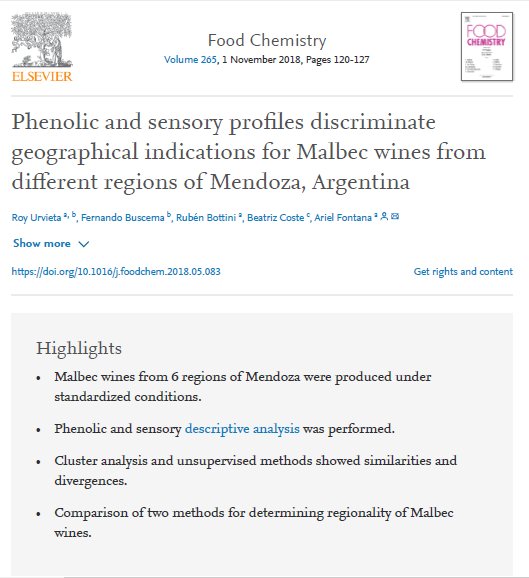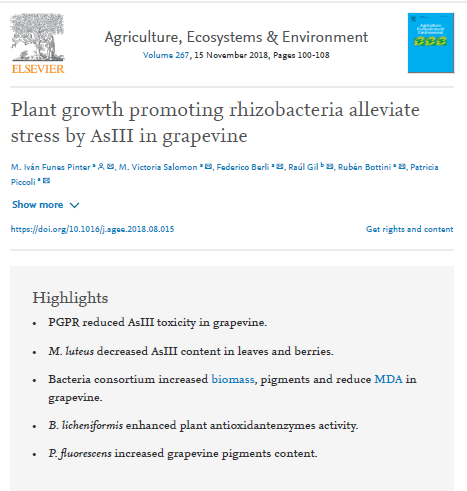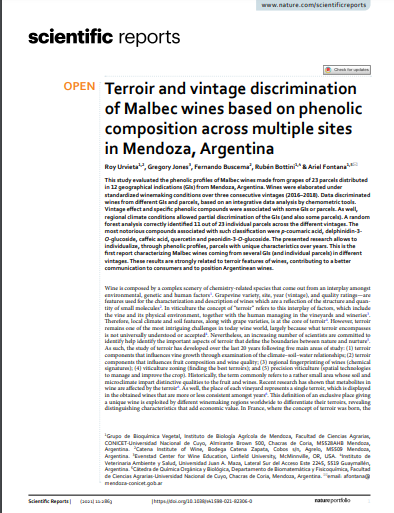Browsing by Author "Bottini, Rubén"
Now showing items 1-9 of 9
-
Abscisic acid and methyl jasmonic acid module anthocyanins and trans-resveratrol accumulation in berry skin of five red Vitis vinifera cvs. in two contrasting viticultural regions of Mendoza-Argentina.
Malovini, Emiliano; Arancibia, Celeste; Durán, Martín; Fontana, Ariel; Deis, Leonor; Gargantini, Raquel; Bottini, Rubén; Cavagnaro, Bruno; Martínez, Liliana; De Rosas, María inés (Comité editor Revista de la Facultad de Cs. Agrarias, Universidad Nacional de Cuyo., 2019-11-06)Berry skins from red grape cultivars contain significant amounts of polyphenols that contribute to wine quality and provide health benefits. These compounds can be elicited by plant hormones. The aim of this work was to increase the content of anthocyanins (ANT) and trans-resveratrol (T-RES) by application of abscisic acid (ABA) and methyl jasmonate (MeJA) in five red V. vinifera cvs. (Bonarda, Malbec, Syrah, Cabernet Sauvignon, and Pinot Noir), in two Argentinean contrasting growing regions (Santa Rosa and Valle de Uco). Results showed positive and differential effects of ABA and MeJA on the ... -
Abscisic Acid’s Role in the Modulation of Compounds that Contribute to Wine Quality
Alonso, Rodrigo; Berli, Federico; Fontana, Ariel; Piccoli, Patricia; Bottini, Rubén (Comité Editorial Plants Journal, 2021-05-08)Abscisic acid (ABA) plays a crucial role in the plant responses to environmental signals, in particular by triggering secondary metabolism. High-altitude vineyards in Mendoza, Argentina, are exposed to elevated solar ultraviolet-B (UV-B) levels and moderate water deficits (WD), thus producing grapevine berries with high enological quality for red winemaking. Volatile organic compounds (VOCs) and phenolic compounds (PCs) accumulate in the berry skins, possess antioxidant activity, and are important attributes for red wine. The aim of the present study was to analyze the role of ABA in the ... -
Bioactive compounds and total antioxidant capacity of cane residues from different grape varieties
Ferreyra, Susana Gisela; Antoniolli, Andrea; Bottini, Rubén; Fontana, Ariel (Comité editorial Journal of the Science of Food and Agriculture, 2019-10-08)BACKGROUND Every year, the viticulture activity generates considerable amounts of underused lignocellulosic residues as grape cane, which are generally composted or burned despite their potential value as a source of bioactive compounds. Determination of their phytochemical composition and total antioxidant capacity (TAC) may be a useful way of exploiting different high‐added value applications. RESULTS Twenty‐one phenolic compounds (PC) and two carotenoids (Car) were quantified by high performance‐liquid chromatography‐diode array detection in eight grape varieties from different locations ... -
Comunicación de resultados de investigación
Bottini, Rubén (2020-06-28)Este video pertenece a una clase dictada en el marco del Programa de Formación en Competencias de Investigación, perteneciente al Área de Ciencia y Técnica de la UMaza. La comunicación de resultados de investigación es el Eje 3 de Programa. La capacitación fue dictada on line. -
Girdling of shoots at flowering reduces shatter in grapevine cv. Malbec.
Carrillo, Natalia; Piccoli, Patricia; Bottini, Rubén; Rodríguez, José; Berli, Federico (Comité editorial Australian Journal of Grape and Wine Research, 2020-02-17)Background and Aims Some grapevine cultivars such as Malbec have unstable yield, due to poor fruitset or fruitlet abscission. The phenomenon is known as ‘shatter’ and this study aims to explore the potential of applying the shoot girdling technique at flowering, to direct the carbohydrate partitioning towards inflorescences and reduce shatter. Methods and Results Fruitful Malbec shoots were girdled above the apical bunch, below the basal bunch, double girdled or not girdled (Control) during 2017 and 2018. Most vegetative growth parameters were unaffected, but shoots widened and the leaf ... -
Nitric oxide and abscisic acid regulate osmoprotective and antioxidative mechanisms related to water stress tolerance of grapevines
Pontin, Mariela; Murcia, Germán; Bottini, Rubén; Piccoli, Patricia; Fontana, Ariel; Bolcalto, Leonardo (Comité editorial Australian Journal of Grape and Wine Research, 2021-03-22)Exogenously applied nitric oxide (NO) and abscisic acid (ABA) are known to improve the tolerance of plants to abiotic stress. The effects of NO and ABA applications on physiological and metabolic responses associated with vine protection against water stress were analysed. -
Phenolic and sensory profiles discriminate geographical indications for Malbec wines from different regions of Mendoza, Argentina.
Urvieta, Roy; Buscema, Fernando; Bottini, Rubén; Fontana, Ariel (Comité Editorial Food Chemistry., 2018-11-01)Malbec wines from 27 parcels from the three most important winemaking regions of Mendoza, Argentina, were produced under standardized winemaking conditions, and analyzed for phenolic composition and by means of sensory descriptive analysis. Different methods of characterization and cluster analysis for each data matrix showed that some locations of Mendoza could be significantly separated from each other. The results of unsupervised statistical methods were compared using a test for similarities and divergences, also showing that different locations may be associated. The current report is the ... -
Plant growth promoting rhizobacteria alleviate stress by AsIII in grapevine.
Funes Pinter, Mariano Iván; Salomón, María Victoria; Berli, Federico; Gil, Raúl; Bottini, Rubén; Piccoli, Patricia (Comité Editorial Agriculture, Ecosystems and Environment., 2018-11-15)Arsenic (As) in the environment is an increasing problem all over the world that limits crop yield, and therefore, remediation strategies like inoculation with plant growth promoting rhizobacteria (PGPR) are necessary. The objective of the current study was to assess PGPR ability to reduce AsIII toxicity in grapevine (Vitis vinifera L. cv. Malbec). Two-year old grape plant-sprouts grown in 10 L pots were inoculated weekly with Bacillus licheniformis, Micrococcus luteus, Pseudomonas fluorescens, a consortium of the three strains, or water (control). Plants were irrigated with water (-As) or a 50 ... -
Terroir and vintage discrimination of Malbec wines based on phenolic composition across multiple sites in Mendoza, Argentina
Urvieta, Roy; Jones, Gregory; Buscema, Fernando; Bottini, Rubén; Fontana, Ariel (Scientifics Reports Editorial, 2021-02-03)This study evaluated the phenolic profiles of Malbec wines made from grapes of 23 parcels distributed in 12 geographical indications (GIs) from Mendoza, Argentina. Wines were elaborated under standardized winemaking conditions over three consecutive vintages (2016–2018). Data discriminated wines from different GIs and parcels, based on an integrative data analysis by chemometric tools. Vintage effect and specific phenolic compounds were associated with some GIs or parcels. As well, regional climate conditions allowed partial discrimination of the GIs (and also some parcels). A random forest ...







